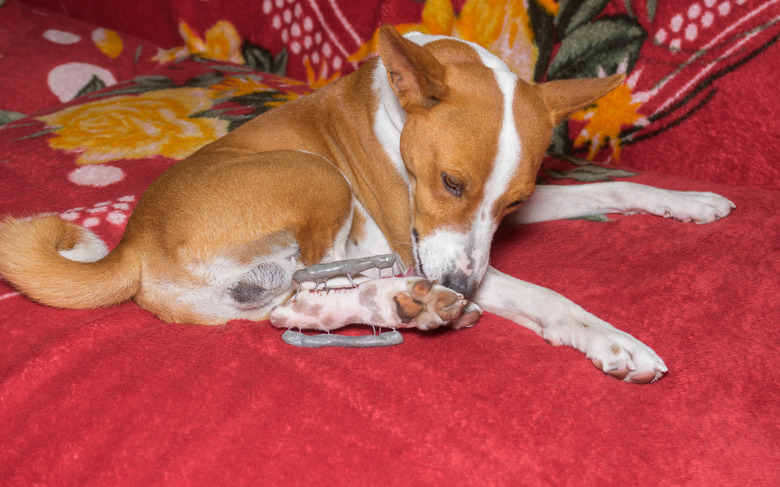How To Keep A Dog From Licking Its Stitches
Stitches can pull at sensitive skin and can cause itching as wounds heal. Your dog might try to scratch, lick or bite her stitches to stop these sensations — but doing any of these things may result in damage to her wound. A dog licking stitches can pull the stitches out, keep the wound too moist, or cause other problems that may lead to infection. Fortunately, there are several ways to prevent her from licking at her stitches, most of which are inexpensive and easy to apply.
Wear an Elizabethan collar
Wear an Elizabethan collar
Veterinarians frequently prescribe the Elizabethan collar, also known as the E-collar, for post-surgical care to keep a dog from licking stitches. E-collars are generally rigid and easy to fit. Most do not require accurate measurements to be effective, as they are designed to wrap around a dog's neck and secure in place with tape, gauze or tabs that fit in a series of slots.
E-collars and other cone alternatives for dogs are suitable for protecting most post-surgical sites. However, they are large and bulky, and even though they are translucent, they make it difficult for dogs to walk without bumping into things. Some dogs take several days to adjust to wearing a cone and may be reluctant to eat while wearing one. Newer E-collar styles have shorter sides made of flexible fabric and transparent plastic.
Neck braces for dogs
Neck braces for dogs
A canine neck brace provides an alternative to the Elizabethan collar. Most commonly used neck braces are form-fitting, rigid, padded plastic collars that prevent a dog from bending her neck. She can still freely move her body and lower her head to eat or drink but she can't get her mouth close enough to the wound to lick the stitches. An inflatable vinyl neck brace is a variation of the rigid neck brace; and it may be suitable in some cases for keeping a dog from licking her stitches.
Wound coverings for dogs
Wound coverings for dogs
Bandaging can be used to keep your dog from licking stitches on the site of many types of wounds, but it is not always practical, especially if the dog is active or is likely to get wet. Leg bandages can be covered with plastic bags that have been secured in place using nonirritating surgical tape.
Wounds on a dog's trunk or abdomen, such as those resulting from shoulder or spay surgery, can be covered with clothing, such as a loosely fitting shirt or sweater designed for dogs, or even a child's T-shirt. Although clothing will not prevent stitches from getting wet and will not deter a dog determined to get to the wound, they provide an effective barrier that will discourage a dog from licking.
Topical liquids for wound protection
Topical liquids for wound protection
Specially formulated liquids are often applied to bandages covering wounds or stitches to give the area a bitter, unattractive taste which help stop a dog from licking stitches. Your veterinarian may recommend an over-the-counter taste deterrent, such as Chew Guard spray or Grannick's Bitter Apple, or Stoplik, a lick deterrent sold only through veterinarians, for this purpose.
Deterrents aren't recommended for punishments, but when your pet's health depends on them being able to leave their stitches alone, it could be a good time to use a product like this. Apply such sprays and liquids to wound coverings only, as applying them to the stitched area can actually encourage licking by irritating the wound. Not all dogs are affected by these lick deterrents so your dog may simply need more supervision during the healing process to be sure he can leave his stitches alone.


